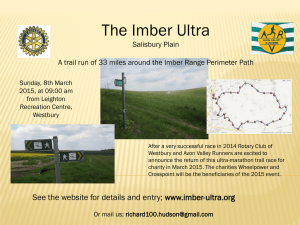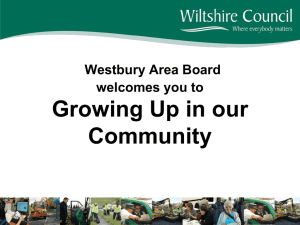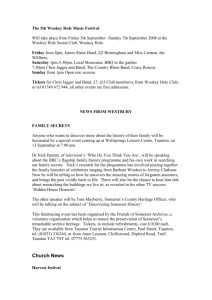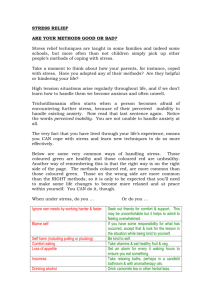Westbury Lecture
advertisement
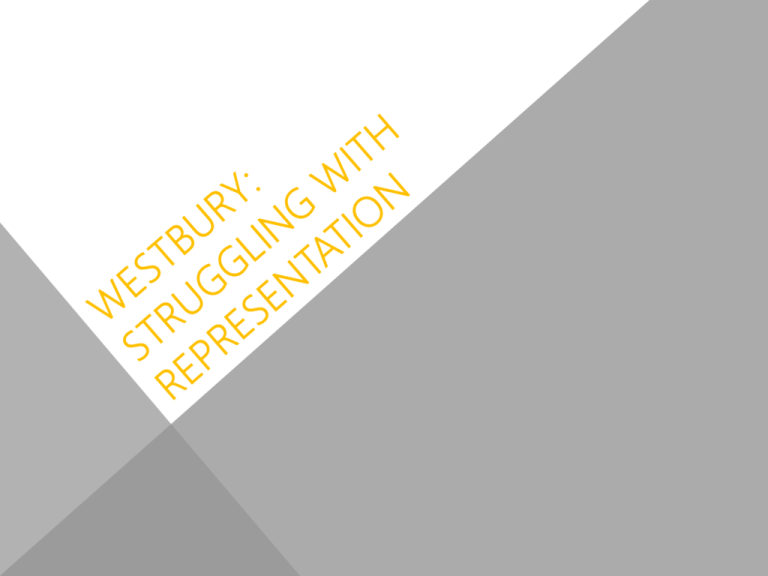
PLAN OF THE LESSON - Your turn - Westbury in the larger context of the city of Joburg - Discussion with Mr S Constant: - What are the challenges of people in Westbury? - How do people try to make another place of and life in W.? - What is ‘Local Studio’? CONTEMPORARY MEDIA The SUN, Published: 2011-01-22 Jodi Bieber, Fast Gun ….“inadequacy of representational systems as a stand in for lived experience” (Renov,1993:7, quoted by Dannhauser 2006: 7) HISTORY OF WESTBURY & THE ‘WESTERN AREAS’ HISTORY OF WESTBURY - Today’s Westbury: Founded as WESTERN NATIVE TOWNSHIP, 1918 - WESTERN COLOURED TOWNSHIP - Today: WESTBURY - Known as part of the then so-called “WESTERN AREAS” Image Photograph: Western Native Township 1958: Chapman after Beinart, 1975:160 “WESTERN AREAS” - Sophiatown, Newclare, Martindale, Western Native Township ( the latter controlled by Johannesburg City Council) - “The point was that the Western Areas were not locations but suburbs. “ (Lodge, The Destruction of Sophiatown, 114) -“The Western Areas also provided opportunities for prostitution, gambling, casual craftwork, and hawking, which - given the absence of municipal regulations and the geographical situation of the suburbs - were rather more profitable than elsewhere. Another response to material conditions was gangsterism. “ (ibid) -“These social categories should be seen as fluid and blurred at the edges. “ Increasingly overcrowded due to: - ‘Slum Clearances’ - Migration to the cities - Structure of the city laid out by Apartheid rule 1920S AND 1930S “The late 1920s and early 1930s saw increased concern over violence in the Western Areas, yet officials could still refer to W.N.T. as a 'model' location as late as 1930-1. Thereafter criminality seems to have increased markedly, but it was only in the middle of the decade that the Western Areas became noted for crime, particularly violence and theft.” From the paper: D. Goodhew: Between the Devil and the Deep Blue Sea: Crime, Policing and the Western Areas of Johannesburg, c.1930 – 1962. Presented at Wits Historical Workshop, Feb 1990. (EduLink) - Group Areas Act – declared ‘coloured’ - Area ‘Development Plan’ -- Western Coloured Township --- Changes in the layout of the suburb - Playcourts – pedestrian & vehicles intersecting - Lack of private/family space. APARTHEID LEGISLATION - 1950 Group Areas Act -declared “coloured” - Forced Removals of residents, eg from Sophiatown - Spatial control - Movement control. - “suppress the mobilisation of black opposition (…) , secondly, they proposed to meet the demands of white farmers and white workers for an effective administration of influx control that would prevent Africans leaving the countryside to settle permanently in the city and undermine the jobs of white workers” (Unterhalter, 10) PRE-APARTHEID LEGISLATION • “Natives Land Act, No 27 of 1913” • ”Natives (Urban Areas) Act of 1923” • (…) EFFECTS OF LEGISLATIONS (AMONGST OTHERS..) URBAN/RURAL SPACE FAMILY STRUCTURES GENDER RELATIONS SPACE MATTERS… •Private and public spaces •Privacy •Safety/Security •Community / Individual HOW TO ANALYSE SPACE.. “In moving beyond the highly descriptive phase of urban history new paradigms are required to approach the question of the place of race in the city. “ (Mabin, p 43) De Certeau, Michel The Practice of Everyday Life. 1974; Berkeley: University of California Press, 1984. Translated by Steven Rendall. HISTORY OF CRIME & RESISTANCE - Western Native Township Tram boycott - Organised by Anti-Tram Fare Action Committee - 1939 Beer Hall Boycott - 1 November 1949 - clash police – residents - 29 January 1950: clash police-residents because of liquor --- setting an Asian store alight - 1980s Residents, LTA and government in conflict over space & redevelopment of ‘Westbury’ A HISTORY OF WOMEN - Strong role of mothers & other women PHYSICAL STRUCTURE & SOCIAL LIFE • Overcrowded, lack of private space • Planned environment Changing Perspectives CONTEMPORARY MEDIA “One of the player's childhood friends, Branwynn Scheeders,said: "There's another big gang-fight going on at the moment. We had a funeral last week and there's another one at the weekend too. "It's all over drug-dealing — 'tic', cocaine and heroin. Westbury has improved since Steven lived here but after the shootings everyone is scared to go out at night. "The real problem is the police — they are afraid to come in here. A lot of them get paid off by the gangsters and murders aren't solved.’ “ GANGSTERISM / RITUALS “In the urban context, however, the importance of ritual has been submerged in the struggle for survival and young people devise their own rites of passage. ‘They create structures and rituals that work for them, carve their names into the ghetto walls and the language of popular culture, arm themselves with fearsome weapons and demand at gun-point what they cannot win with individual respect. (Pinnock, 1996)’” From: Dissel, A: Youth, Street Gangs and Violence in South Africa. In Youth, Street Culture and Urban Violence in Africa, proceedings of the international symposium held in Abidjan, Ivory Coast, pp. 405-411, 5-7 May 1997. http://www.csvr.org.za/wits/papers/papganga.htm POINTS BY DANNHAUSER: • ‘Race’ as a marker of ‘difference’: “Coloured community in South Africa by the fact that race has always been used as a marker of difference. During the apartheid era, the position of Coloured communities, and Westbury in particular, was circumscribed by the politics of segregation. This marginalisation was exacerbated by the ‘justifiable’ view from the outside, based on evidence of police records and media reports, of Coloured culture as violent and unstable.” (p2) COMPARE ALAN MABIN - “'Race': The A Priori Category of Urban Studies: Typically articles on South African cities begin with a note on racial categorisation and terminology. The official designations of the state are denounced and the authors assert their opposition to artificial racial classifications. Nonetheless, race remains the ubiquitous lens through which the South African city is viewed. “ (40) RECENT HISTORICAL EVENTS • 2000: TAG (Together Action Group) is formed • 2001: rallye initiated by churches – ‘reconciliation’ • 2011: LOCAL STUDIO IS FORMED LOCAL STUDIO FINANCIAL MAIL 8.9.2011 http://www.fm.co.za/Article.aspx?id=152872 “This project begins with the notion that in ‘entering through the backdoor’ one is able to look past the stigmas that brand a community such as Westbury: stigmas which entrench and exacerbate the divide between a desolate past and a hopeful future. ” http://snwe.tumblr.com/post/3065001180/bttc -1-introduction-to-westbury PLACE-MAKING “Placemaking is a multi-faceted approach to the planning, design and management of public spaces. Put simply, it involves looking at, listening to, and asking questions of the people who live, work and play in a particular space, to discover their needs and aspirations. This information is then used to create vision a common for that place. The vision can evolve quickly into an implementation strategy, beginning with small-scale, do-able improvements that can immediately bring benefits to public spaces and the people who use them.” http://www.pps.org/articles/what_is_placemaking/ SOCCER DAY PARK DAY TOUR ‘MEMORY IN THE CITY’ CONFERENCE PROJECT – THE SHOP Filip De Boek – Kinshasa: Tales of the Invisible City “What it needs in order to operate a garage is not a garage itself, but the idea of a garage”
